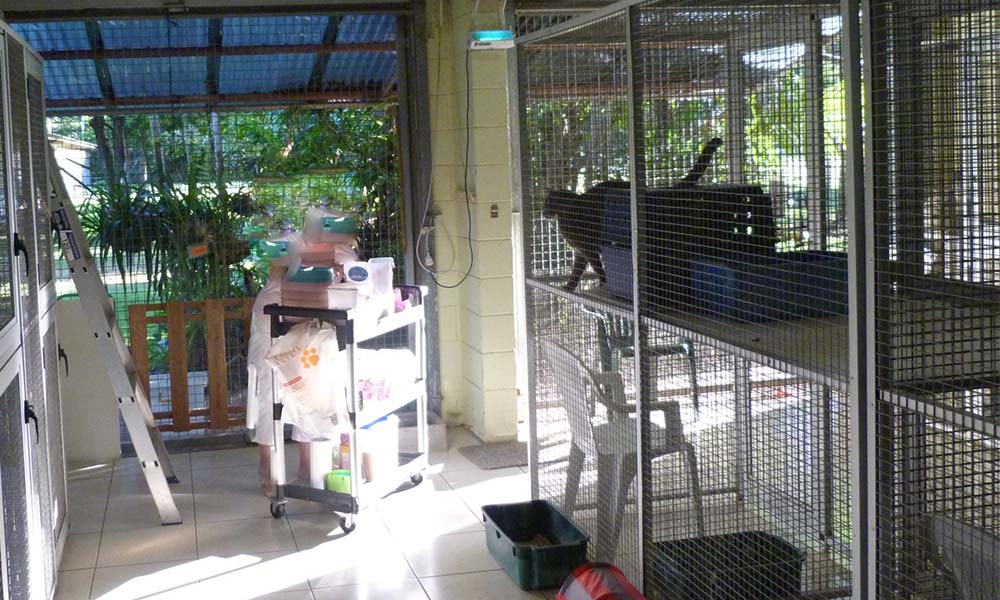Ever wondered what goes on behind the scenes when you leave your beloved feline at a cattery? For many cat owners, the thought of boarding their pet can trigger feelings of guilt, especially when imagining their cat cooped up in a confined space.
But did you know that one of the most important aspects of a quality cattery is its cross-flow ventilation system? Without proper airflow, your cat’s stay could be far from comfortable, potentially leading to anxiety, illness, or worse.
So, how can we ensure the best environment for our cats while we’re away on holiday?
Enter cross-flow ventilation – an essential feature that guarantees fresh air circulation, helping to maintain clean air, regulate temperatures, and keep your cat healthy and happy. In this blog, we’ll explore why this ventilation system is crucial for your feline companion’s well-being
What Exactly Is Cross-Flow Ventilation in Cat Boarding?
Cross-flow ventilation refers to the system of natural airflow created by strategically positioned windows or vents that allow fresh air to enter and stale air to exit.
This continuous movement of air helps prevent stuffiness and odours from building up, which can lead to an unhealthy environment, particularly in enclosed spaces like cat boarding facilities.
For our feline friends, this isn’t just a matter of convenience—it’s about their overall well-being.
Here’s why:
- Reduces airborne bacteria: Cats are prone to respiratory illnesses, and poor air quality can aggravate these conditions. Ventilation helps keep the air fresh and free from harmful bacteria.
- Regulates temperature: Cats can become stressed if the temperature isn’t just right. Cross-flow ventilation ensures that hot air doesn’t get trapped inside.
- Minimises stress: Fresh air can help create a calmer atmosphere, reducing anxiety in cats during their stay.
Why Does Cross-Flow Ventilation Matter in Cat Boarding?
We know that cats are incredibly sensitive creatures, often responding to the slightest environmental changes.
Here’s why cross-flow ventilation is a game-changer for their boarding experience:
1. Maintains Clean Air
Imagine sitting in a room with no ventilation—stale air, odours, and bacteria would quickly build up. Now think about how your cat might feel after a day or two in a poorly ventilated space. Cross-flow ventilation in cat boarding ensures fresh, clean air is constantly circulating, eliminating unpleasant odours and reducing the risk of infections or respiratory issues.
2. Temperature Control
Cats are notorious for being picky about their surroundings, and that includes the temperature. Without proper ventilation, heat can quickly build up, making your feline friend uncomfortable and irritable. Cross-flow ventilation prevents the build-up of heat by circulating air, which naturally cools the space.
3. Reduces Stress and Anxiety
Cats thrive in environments where they feel safe and comfortable. Poor air quality, stuffiness, and lingering smells can make them anxious. However, good airflow, created by cross-flow ventilation, promotes a calm environment.
In fact, boarding facilities like Cat Castle offer stress-free environments where your cat can relax, with no dogs around to disturb them. This type of care ensures your cat has a ‘holiday’ when you do.
The Benefits of Cross-Flow Ventilation in Cat Boarding
1. Stress-Free Environment
One of the major perks of a well-ventilated cat boarding facility is that your cat won’t feel like they’re stuck in an unpleasant, stuffy space.
Cats live in the “now,” meaning whether you’re away for three days or three weeks, they’ll settle into their environment as long as it’s comfortable. No need to feel guilty for leaving them behind!
2. Prevention of Respiratory Issues
Cats are more susceptible to respiratory problems when exposed to poor air quality. Dust, odours, and stale air can exacerbate conditions like asthma and bronchitis. With cross-flow ventilation, these risks are significantly reduced because fresh air is always moving through the space, keeping harmful particles at bay.
3. No Territory Issues
Unlike at-home care, where cats might feel the need to be territorial, cross-flow ventilation in a boarding environment helps keep the air clean and free of scents that might provoke aggressive or territorial behaviour.
Since the cattery is a “neutral zone,” your cat won’t feel the need to mark territory or display defensive behaviours. In fact, many cats become quite sociable in this type of space, adjusting quickly and harmoniously with other boarders.
4. Increased Socialisation Opportunities
Because of the neutral territory in boarding facilities, cats can interact without feeling territorial or aggressive. With proper air circulation, the atmosphere remains calm, helping cats adjust to their new surroundings more easily and even encouraging them to socialise.
Key Features of an Ideal Cat Boarding Facility with Cross-Flow Ventilation
When choosing a cat boarding facility, it’s important to ask about their ventilation system. Here’s a quick checklist:
- Are there multiple windows or vents to facilitate cross-flow ventilation?
- Is the facility temperature-controlled?
- Are there areas where the cats can relax away from other pets, particularly dogs?
- Does the facility have regular cleaning protocols that support fresh air circulation?
Ensuring these factors are met guarantees a much more comfortable stay for your cat.
How Cross-Flow Ventilation Compares to Other Ventilation Systems
You might be wondering how cross-flow ventilation stacks up against other systems commonly used in pet boarding facilities.
Let’s break it down:
- Mechanical Ventilation: While mechanical systems, such as fans or air conditioning, can provide airflow, they often recirculate the same air, which may not be as fresh as natural airflow.
- Natural Ventilation: Windows can be opened for fresh air, but without a system to direct airflow, the air may not move through the entire space effectively.
- Cross-Flow Ventilation: This system is the most efficient for cat boarding facilities as it ensures continuous, natural airflow across the entire space.
Wrapping It Up
There’s no question that cross-flow ventilation in cat boarding plays a critical role in ensuring your pet’s comfort and health.
From maintaining fresh, clean air to reducing stress and preventing illness, this simple feature can make all the difference in your cat’s stay.
Don’t let guilt hold you back from enjoying your holiday—your cat can have a stress-free, luxurious stay at Cat Castle, where they’ll enjoy the same comforts of home, or perhaps even more!
Ready to ensure your cat’s next boarding experience is a safe and comfortable one? Book your cat’s stay.
Frequently Asked Questions
Fresh air and good airflow reduce odours, heat, and stuffiness, creating a calmer environment where cats can relax and feel safe.
While air conditioning helps with temperature control, it doesn’t offer the same natural, fresh airflow that cross-flow ventilation provides. Fresh air reduces bacteria and odours more effectively.
Yes, it helps reduce the build-up of airborne bacteria, dust, and allergens, which can trigger respiratory problems in cats.
Look for well-placed windows or vents that allow air to move freely. Ensure the facility is clean and maintains a calm, dog-free environment to further reduce stress.
Yes! It relies on natural airflow, making it a more eco-friendly and cost-effective option compared to constantly running fans or air conditioners.





